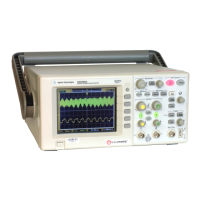Vertical Controls
Math Functions Control
2-17
Using the FFT
The FFT math function mathematically converts a time-domain waveform into
its frequency components. FFT waveforms are useful for finding the harmonic
content and distortion in systems, for characterizing noise in DC power supplies,
and for analyzing vibration.
Selecting an FFT Window
There are 4 FFT windows. Each window has trade-offs between frequency
resolution and amplitude accuracy. Your source waveform characteristics along
with your measurement priorities help determine which window to use. Use the
following guidelines to select the best window.
Table 2-4
FFT Windows
The FFT of a waveform that has a DC component or offset can cause incorrect FFT
waveform magnitude values. To minimize the DC component, choose AC Coupling
on the source waveform.
To reduce random noise and aliasing components in repetitive or single-shot
waveforms, set the oscilloscope acquisition mode to averaging.
To display FFT waveforms with a large dynamic range, use the dBVrms scale. The
dBVrms scale displays component magnitudes using a log scale.
Window Characteristics Best for measuring
Rectangle Best frequency resolution, worst
magnitude resolution. This is
essentially the same as no window.
Symmetric transients or bursts.
Equal-amplitude sine waves with fixed
frequencies. Broadband random noise
with a relatively slowly varying spectrum.
Hanning and
Hamming
Better frequency, poorer magnitude
accuracy than Rectangular. Hamming
has slightly better frequency resolution
than Hanning.
Sine, periodic, and narrow-band random
noise. Asymmetic transients or bursts.
Blackman Best magnitude, worst frequency
resolution.
Single frequency waveforms, to find higher
order harmonics.

